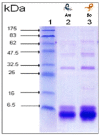Comparative Proteomic Analysis of the Venoms from the Most Dangerous Scorpions in Morocco: Androctonus mauritanicus and Buthus occitanus
- PMID: 37240778
- PMCID: PMC10222527
- DOI: 10.3390/life13051133
Comparative Proteomic Analysis of the Venoms from the Most Dangerous Scorpions in Morocco: Androctonus mauritanicus and Buthus occitanus
Abstract
Morocco is known to harbor two of the world's most dangerous scorpion species: the black Androctonus mauritanicus (Am) and the yellow Buthus occitanus (Bo), responsible for 83% and 14% of severe envenomation cases, respectively. Scorpion venom is a mixture of biological molecules of variable structures and activities, most of which are proteins of low molecular weights referred to as toxins. In addition to toxins, scorpion venoms also contain biogenic amines, polyamines, and enzymes. With the aim of investigating the composition of the Am and Bo venoms, we conducted an analysis of the venoms by mass spectrometry (ESI-MS) after separation by reversed-phase HPLC chromatography. Results from a total of 19 fractions obtained for the Am venom versus 22 fractions for the Bo venom allowed the identification of approximately 410 and 252 molecular masses, respectively. In both venoms, the most abundant toxins were found to range between 2-5 kDa and 6-8 kDa. This proteomic analysis not only allowed the drawing of an extensive mass fingerprint of the Androctonus mauritanicus and Buthus occitanus venoms but also provided a better insight into the nature of their toxins.
Keywords: Androctonus mauritanicus; Buthus occitanus; mass fingerprinting; mass spectrometry; proteomics; scorpion; venom.
Conflict of interest statement
The authors declared no potential conflict of interest with respect to the research, authorship, and/or publication of this article.
Figures






Similar articles
-
Mass spectrometry-based top-down and bottom-up approaches for proteomic analysis of the Moroccan Buthus occitanus scorpion venom.FEBS Open Bio. 2021 Jul;11(7):1867-1892. doi: 10.1002/2211-5463.13143. Epub 2021 May 28. FEBS Open Bio. 2021. PMID: 33715301 Free PMC article.
-
Comparison of the neurotoxic and myotoxic effects of two Moroccan scorpion venoms and their neutralization by experimental polyclonal antivenom.Life Sci. 2015 Mar 1;124:1-7. doi: 10.1016/j.lfs.2014.12.031. Epub 2015 Jan 24. Life Sci. 2015. PMID: 25623852
-
Induced pathophysiological alterations by the venoms of the most dangerous Moroccan scorpions Androctonus mauretanicus and Buthus occitanus: A comparative pathophysiological and toxic-symptoms study.Hum Exp Toxicol. 2022 Jan-Dec;41:9603271211072872. doi: 10.1177/09603271211072872. Hum Exp Toxicol. 2022. PMID: 35130762
-
[Scorpion envenomation in Morocco: scorpions of the genus Androctonus, Buthus and Hottentota].Bull Soc Pathol Exot. 2014 Feb;107(1):39-47. doi: 10.1007/s13149-014-0332-7. Epub 2014 Jan 8. Bull Soc Pathol Exot. 2014. PMID: 24402964 Review. French.
-
Epidemiological, toxicological and physiopathological characteristics of scorpion stings and their management in Morocco: A literature review.Acta Trop. 2023 Mar;239:106812. doi: 10.1016/j.actatropica.2022.106812. Epub 2022 Dec 31. Acta Trop. 2023. PMID: 36596437 Review.
References
-
- Lourenco W.R. Diversity and endemism in tropical versus temperate scorpion communities. C. R. Séances Soc. Biogéogr. 1994;70:155–160.
-
- Briggs D.E.G. Scorpions take to the water. Nature. 1987;326:645–646. doi: 10.1038/326645a0. - DOI
-
- Lourenço W.R., Cuellar O. Scorpions, scorpionism, life history strategies and parthenogenesis. J. Venom. Anim. Toxins. 1995;1:51–62. doi: 10.1590/S0104-79301995000200002. - DOI
Grants and funding
LinkOut - more resources
Full Text Sources


